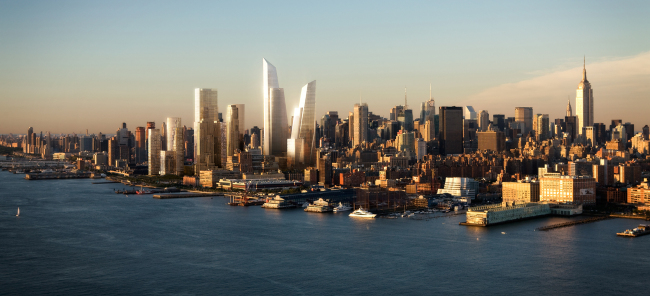NEW YORK (AP) ― New York lost the 2012 Olympics, but the city’s bid for the summer games spurred another, visionary venture: building up the largest undeveloped parcel in Manhattan.
While London got the games, New York was left with the best opportunity for development remaining in town.
On Manhattan’s West Side, the old Hudson rail storage yards are surrounded by potholed roads, warehouses, low-rent brownstones, cheap delis and strip clubs. Crowds waiting for discount buses line 10th Avenue. And homeless New Yorkers camp out in desolate lots strewn with garbage.
But the area, also home to the global headquarters of The Associated Press, has seen progress in the seven years since New York lost its bid to host the Olympics.
While London got the games, New York was left with the best opportunity for development remaining in town.
On Manhattan’s West Side, the old Hudson rail storage yards are surrounded by potholed roads, warehouses, low-rent brownstones, cheap delis and strip clubs. Crowds waiting for discount buses line 10th Avenue. And homeless New Yorkers camp out in desolate lots strewn with garbage.
But the area, also home to the global headquarters of The Associated Press, has seen progress in the seven years since New York lost its bid to host the Olympics.

On a hot summer day, passers-by catch a glimpse of a deep man-made hole in the ground ― the core of a subway line extension to the area from Times Square. More than a dozen residential towers have been built near the Hudson River, along with several hotels. And both residents and tourists are flocking to the hugely popular High Line, an elevated rail line transformed into a grassy walkway.
This October, developers of the ambitious Hudson Yards project expect to break ground on a skyscraper where the Olympic stadium could have been.
It’s the first step in a $15 billion small city within a city planned for 26 acres of land by the river, bounded by 10th and 12th avenues and West 30th and 33rd streets.
Hudson Yards “is not just another development ― it’s part of a larger effort to create a physical infrastructure for a multi-decade expansion of New York City,” says Lynne Sagalyn, professor of real estate at Columbia Business School.
Turning the isolated waterfront into Manhattan’s next big business district has been a dream of city leaders for years. The city rezoned a 60-block stretch of the West Side to accommodate 2.32 million sq. meters of office space expected to rise as midtown Manhattan runs out of room. Mayor Michael Bloomberg envisions a development that could eventually change the skyline ― “a historic project that will create jobs for generations to come,” he says.
The effort to bring this megaproject to life hasn’t exactly been harmonious.
Years of bitter wrangling among politicians, business people and residents focused around a proposed football stadium for the Jets meant to help win the city the Olympics. The stadium fell short of state approval; opponents questioned the benefit of publicly financing a structure with limited use and possible traffic gridlock.
Then came various plans for Hudson Yards, which still has its virulent opponents.
Kathleen Treat, of the Hell’s Kitchen Neighborhood Association named after an old adjacent area, calls Hudson Yards “Hong Kong on the Hudson,” referring to the densely populated Asian city with people living in tightly clustered high-rises.
The plan that eventually took hold calls for completion about a dozen years from now, though even that is hardly guaranteed.
“The question is, are there tenants to anchor the project?” asks Sagalyn.
“The demand has to be strong, while the market can change and things happen you can’t anticipate,” she says.
Other questions loom. The subway extension is at least two years away. The city issued $3 billion in bonds to pay for it, and work has yet to begin on an $800,000 platform covering the rail tracks.
“To build these very large structures on top of the tracks is a huge challenge,” says architect Bill Pedersen, co-founder of the architectural firm Kohn Pedersen Fox Associates, which designed Hudson Yards’ master plan. “It’s like dental work, threading through down below.”
At 12 million square feet (1.11 million sq. meters), Hudson Yards is billed as New York’s most ambitious private construction since the 1930s, with thousands of apartment units including affordable housing.
The project is getting help from the public. The city approved $106 million in property tax exemptions for the first office tower and retail areas. And developers are leasing air rights to the property from the Metropolitan Transportation Authority for 99 years, with purchase options ― for $1 billion to be used for the state agency’s other capital projects.
-
Articles by Korea Herald











![[Today’s K-pop] BTS pop-up event to come to Seoul](http://res.heraldm.com/phpwas/restmb_idxmake.php?idx=644&simg=/content/image/2024/04/17/20240417050734_0.jpg&u=)





![[KH Explains] Hyundai's full hybrid edge to pay off amid slow transition to pure EVs](http://res.heraldm.com/phpwas/restmb_idxmake.php?idx=652&simg=/content/image/2024/04/18/20240418050645_0.jpg&u=20240419100350)

![[Today’s K-pop] Zico drops snippet of collaboration with Jennie](http://res.heraldm.com/phpwas/restmb_idxmake.php?idx=642&simg=/content/image/2024/04/18/20240418050702_0.jpg&u=)